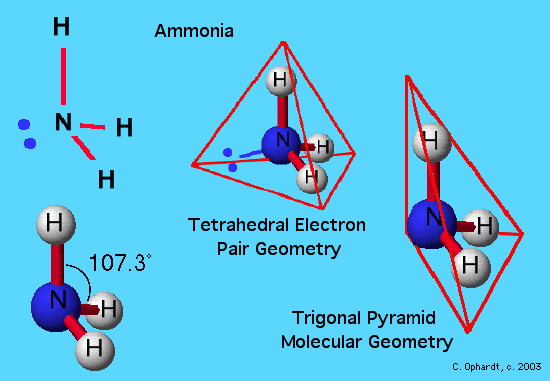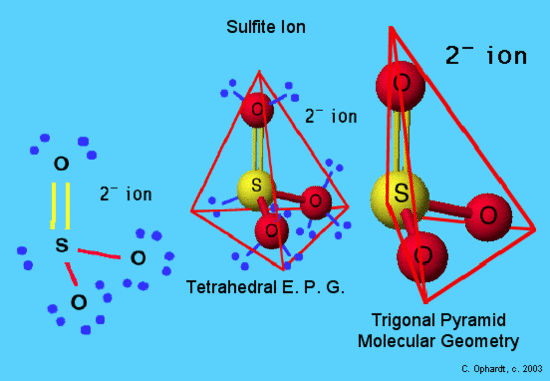Trigonal Pyramidal Molecular Geometry
- Page ID
- 120185
An example of trigonal pyramid molecular geometry that results from tetrahedral electron pair geometry is NH3. The nitrogen has 5 valence electrons and thus needs 3 more electrons from 3 hydrogen atoms to complete its octet. This then leaves a lone electron pair that is not bonded to any other atom. The three hydrogen atoms and the lone electron pair are as far apart as possible at nearly 109o bond angle. This is tetrahedral electron pair geometry.
The lone electron pairs exerts a little extra repulsion on the three bonding hydrogen atoms to create a slight compression to a 107o bond angle.The molecule is trigonal pyramid molecular geometry because the lone electron pair, although still exerting its influence, is invisible when looking at molecular geometry. The molecule is three dimensional as opposed to the boron hydride case which was a flat trigonal planar molecular geometry because it did not have a lone electron pair.

Hydronium Ion
In this example, H3O+, the Lewis diagram shows O at the center with one lone electron pair and three hydrogen atoms attached. Compare this with ammonia, NH3, which also has a lone pair. Compare it to the water molecule which has 2 hydrogen atoms and 2 lone electron pairs.. The third hydrogen bonds to the water molecule as a hydrogen ion (no electrons) bonding to the lone pair on the oxygen.
This shows tetrahedral geometry for the electron pair geometry and and trigonal pyramid the molecular geometry. Hydronium ion is a more accurate method to depict the hydrogen ion associated with acid properties of some molecules in water solution.

Sulfite Ion
In this example, SO32-, the Lewis diagram shows sulfur at the center with one lone electron pair. The sulfur and and one oxygen are bonded through a double bond which counts as "one electron pair". Hence the molecule has four electron pairs and is tetrahedral.
The Lewis diagram is as follows:
S = 6 e-
O = 6e- x 3 = 18e-
2- charge = 2e-
Total electrons = 26
Sulfur atoms and all oxygen atoms have an octet of electrons. Sulfite and bisulfite ions are used as a preservative in wines. It is also found as a component of acid rain, formed by the interaction of sulfur dioxide and water molecules.

Contributors and Attributions
- Charles Ophardt, Professor Emeritus, Elmhurst College; Virtual Chembook

